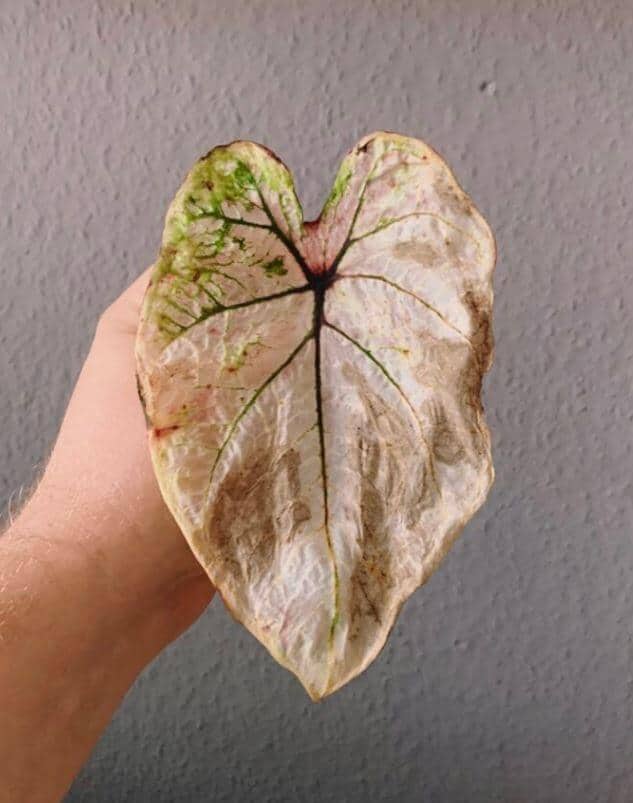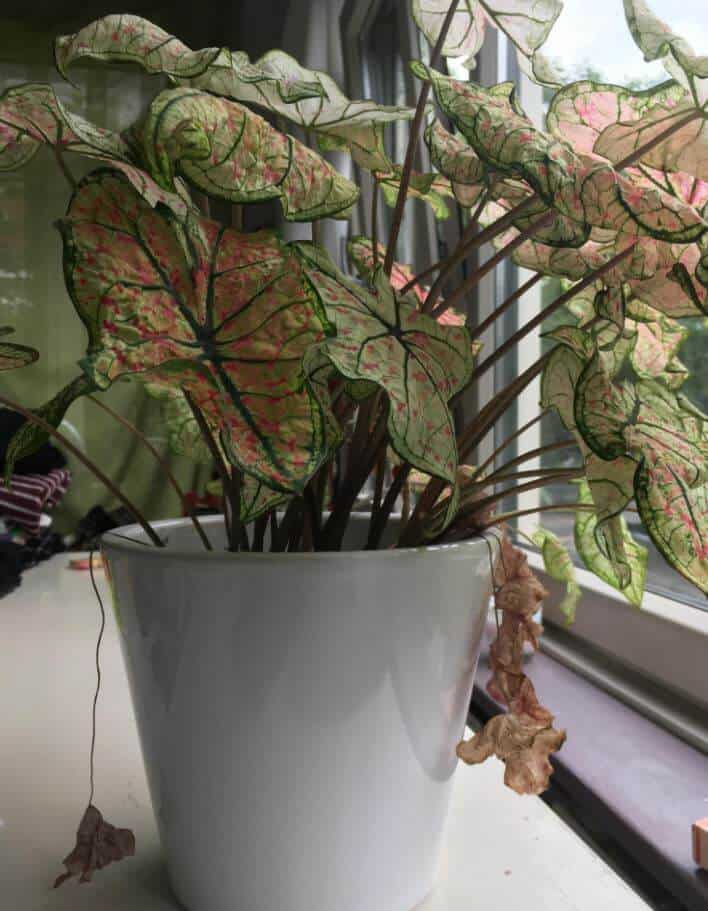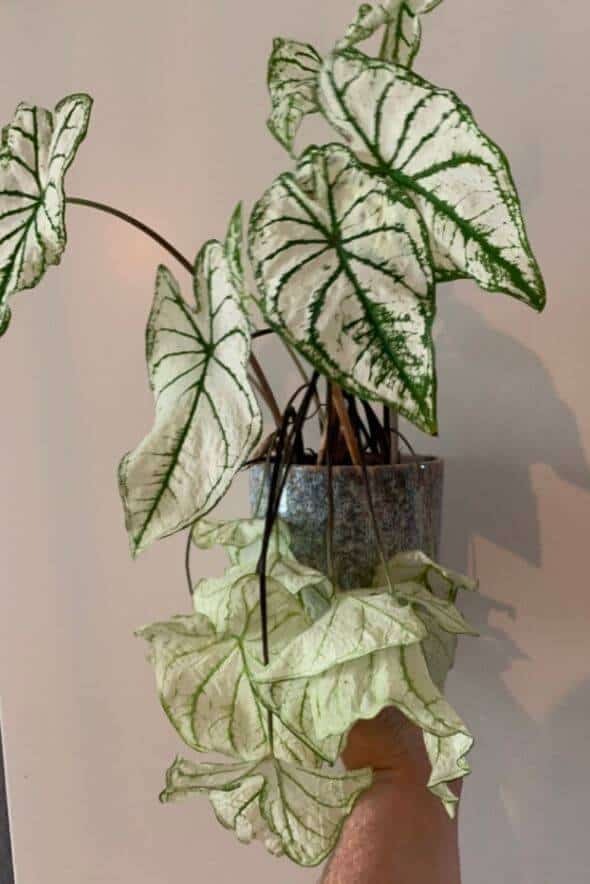Last Updated on August 25, 2023 by a Friendly Gardener
If you enter a garden, whether indoor or outdoor, that has a caladium, it’s impossible not to notice this striking plant. Mother Nature is generous with her color palette when it comes to the Caladium plant: creamy white, brilliant green, shocking pink, orange, and lilac. This plant is truly unique with amply-sized heart-shaped leaves emerging directly from the plant’s tuber. Native to Brazil, Guyana, and the Caribbean islands, the Caladium loves high humidity in the 70% range and warm environmental temperatures.
Although these plants are considered easy-to-care-for, if the proper environmental conditions are not provided, your plant will suffer and die. The principal causes of a Caladium dying include excessive sunlight, overwatering, improper temperatures, and underwatering. Other factors that can negatively affect your Caladium’s health include potting soil quality, fertilizers, and humidity levels.
Why Is My Caladium Dying?

A careful examination of your Caladium will usually indicate the reason your plant is failing, as these plants are quite communicative regarding their state. If you can identify the signal or symptom, you can save your Caladium and aid it in returning to health.
Overwatering
If you provide more water than your plant needs and that the soil can manage, the soil will inevitably become soggy, and this is due to overwatering. If your plant is sitting in the form of mud, this will lead to root infections and root rot. The root system will not receive adequate aeration and oxygen and will slowly drown. The roots will begin to rot, and your plant will die. Yellowing leaves will appear and begin to droop.
What to do
Choose loose, well-draining potting soil and a container with an adequate number of drainage holes so that excess water can drain out. Before watering, check the soil’s wetness or dryness. If the soil is dry approximately two inches deep, you can water. If it is not, wait before watering again.
Underwatering
The opposite of providing too much water is not providing enough water. Underwatering will leave the potting soil too dry and this will eventually result in the dehydration of your plant. Leaf edges will begin to brown, foliage will begin wilting. Leaves may also start to curl in a desperate attempt to impede water loss through transpiration. If left without water for too long, your plant will die. Generally, underwatering is due to negligence or forgetting to water the plant, but excessive sunlight exposure or potting soil without moisture retention capabilities can also contribute to this.
What to do
The best thing you can do is to check how dry your potting soil is at regular intervals. When it feels dry, it’s time to water. Also, cultivate your plant in potting soil that has water retention capabilities or add in some coco peat to increase moisture retention. Make sure you have potted your plant in the correct container size. Very small containers may hold too little potting soil to retain adequate moisture. Also, keep your plant out of direct sunlight which speeds up evaporation.
While there is no rule as to how often you need to water a Caladium, as watering needs vary based on plant size, location, environment, and season.
Excessive Sunlight Exposure

Caladium plants love sunlight as long as it is indirect. Direct sunlight exposure tends to damage foliage. When Caladiums are kept in direct sunlight for lengthy periods, they can experience sunburn. Sunburn can also be the result of abruptly moving a Caladium from the shade into the sun. Sunburn will be evident because leaves will exhibit brown patches. Foliage may also begin to yellow. Prolonged direct sunlight exposure can be lethal.
What to do
Place your Caladium in a spot that receives generous amounts of indirect sunlight. Remember that Caladiums are tropical plants that naturally grow underneath other vegetation, so they are protected. They naturally receive diffused light and rarely are exposed to direct sunlight. Still, they should not be placed in low-light environments because this can impede growth. Sheer curtains in windows can protect your Caladium, or move it several inches back from the window or source of light.
Improper Environmental Temperatures

Caladiums prefer environmental temperatures in the 70° to 75°F range during the daytime and in the 60° to 65° F range at night. They are fussy when it comes to temperature fluctuations and detest the cold. They will die if temps dip to 25°F or less.
What to do
Move your plant to a warmer spot. Keep the Caladium away from cool drafts and air conditioning units or vents.
Low Humidity Levels
Humidity levels are equally important for your Caladium’s health. When humidity levels are too low, leaves will begin to drop and may become yellow. Low humidity will cause your plant to suffer.
What to do
The best thing you can do for your Caladium is locate it in a room with higher humidity levels such as a bathroom. You can also use a space humidifier or group several plants together to create a microclimate through shared transpiration. Pebble trays are always a good idea. You can fill a tray with pretty stones and then fill the tray with water and place it underneath the plant’s container. Trays can contain pebbles or peat moss. Change the water and clean the tray weekly to prevent bacterial growth.
Misting your plant is a temporary solution. Misting will provide foliage with moisture, but it is only a temporary solution as it will not increase the moisture content of the environmental air.
Feeding Issues
Caladiums are sensitive to overfeeding. If you note white salts on the soil surface, this is excess fertilizer. If left in overfertilized soil, your plant may fail.
What to do
Try flushing out the soil three to four times a year when watering. If the soil is compromised, repot your Caladium in fresh potting soil. Use fertilizers sparingly. Try a liquid fertilizer diluted to quarter or half strength only during the growing season.
Improper Soil Quality

A potting soil without water retention will result in dehydration while heavy soil will impede proper drainage. Also, your plant’s soil must provide nutrients like phosphorous and nitrogen if you want your plant to flourish.
What to do
Acquire quality potting soil from your garden center. The addition of some peat will enhance water retention capabilities. Soil pH should measure between 5.5 and 6 or slightly acidic for your Caladium.
In Conclusion

Two other things to keep in mind are pest infestations and disease. Examine your plant weekly for signs of aphids, spider mites, mealybugs, or others, and treat your Caladium with insecticidal soap or neem oil. Wipe leaves often to remove dust which inhibits photosynthesis.
Caladium plants are delightful houseplants. To keep your plant healthy, provide the correct environmental conditions and examine your plant weekly for symptoms of distress. If you intervene early enough, you can revive your plant and save it from dying.

